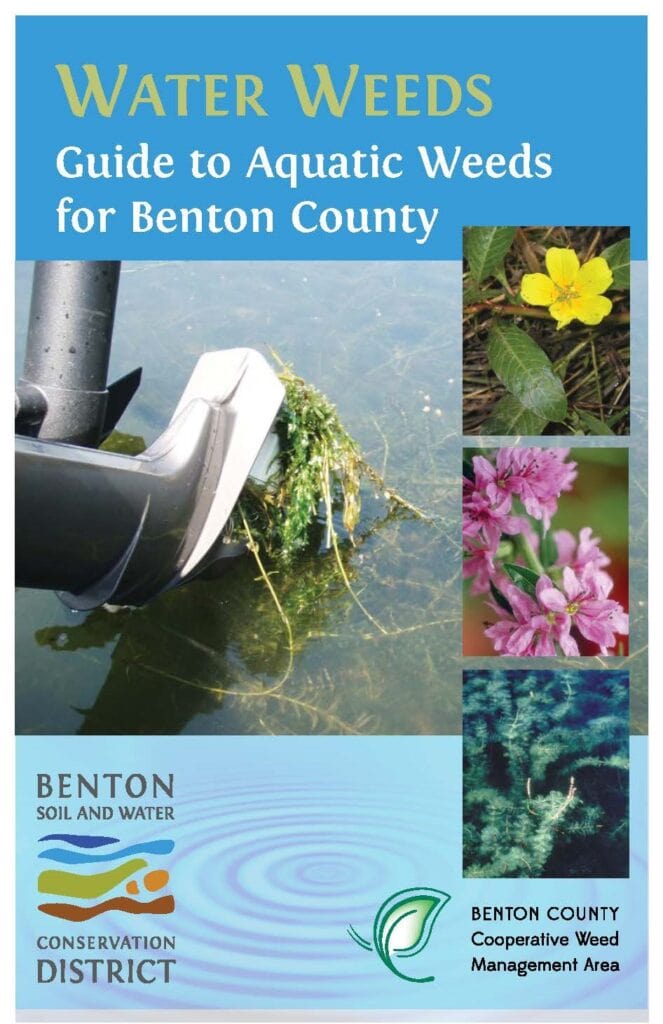Educational Resources
Priority Aquatic Invasive Species
There are many invasives species threatening the Willamette Basin, but also many natives, such as Bresenia scheberi (water shield, pictured above) that can be mistaken as invasives. The Willamette Aquatic Invasives Network has elected to focus on developing a priority Aquatic Invasive Plant list for the Willamette that focuses on aquatic as well as a limited number of priority terrestrial weeds, to be distinguished from native species. There was some consensus around developing a list that broke the aquatic invasive species present in the Willamette down into three general categories; 1) Identify specific plants to prioritize for survey and treatment; 2) a watch list with EDRR species and; 3) other invasives that are present but too widespread to focus on treatment.
Priority Aquatics (emergent and submersed)
- Common reed grass (Phragmites australis)
- Water primroses (Ludwigia hexapetala, L. peploides ssp. peploides,and L. peploides ssp. montevidensis)
- Flowering rush (Botomus umbellatus)
- Yellow floating heart (Nymphoides peltata)
- Parrot feather (Myriophyllum aquaticum)
- Fragrant waterlily (Nymphaea odorata)
- Yellow flag iris (Iris psuedacorus)
- Purple loosestrife (Lythrum salicaria)
- Knotweeds (Polygonum cuspidatum, P. sachalinese, P. x bohemicum, and P. polystachyum)
Watch List
- Hydrilla (Hydrilla verticillata)
- European water chestnut (Trapa natans)
- Eurasian and variable-leaf watermilfoil (Myriophyllum spicatum and M. heterophyllum)
- Garden loosestrife (Lysimachia vulgaris)
- Giant reed grass (Arundo donax)
- Delta and grassy arrowhead (Sagittaria platyphylla and S. graminea)
Other Invasive Species (present but too widespread to address)
- Nutsedges (Cyperus ssp.)
- Pennyroyal (Mentha pulgium)
- Curly pondweed (Potomogeton crispus)
- Brazilian waterweed (Elodea densa)
- Reed canarygrass (Phramites arundinacea)
BSWCD Water Weed Field Guide
Produced in partnership with WAIN, Benton Soil and Water Conservation District has published this aquatic weed guide, focused on a short list of twelve common water weeds in the Willamette Basin. This waterproof, field-ready guide can be viewed online here, or can be purchased directly from BSWCD.
Aquatic Invasive Invertebrates
Invasive invertebrates are a growing issue in Oregon’s waterways, including the Willamette watershed, which has produced a growing educational approach to managing spread, including the campaign initiatives Clean, Drain, Dry and Play, Clean, Go.
Invasive invertebrates that we are concerned about spreading in the Willamette River include:
Aquatic Invasive Species Management Information and Resource List
In efforts to meet the goal of WAIN several members have developed an Aquatic Invasive Species (AIS) Resource list to provide references and information for land managers working with aquatic invasive species.
The AIS Resource List is a summary of resources concerning the management of AIS. This list includes hyperlinks and information about: species of concern; control methods; impacts; management plans; survey and monitoring protocols; reporting databases; permitting and regulations. For easy reference the list is organized by the topics listed below.
- Aquatic Species Information
- General AIS Impacts
- General AIS Management Plans
- General AIS Control Methods
- General AIS Survey & Monitoring Protocols
- Permitting & Regulations
The AIS Resource List will be updated as more information becomes available. Please check back.

Yellow Floating Heart, Nymphoides hexpetala, was discovered on the Willamette in 2016.


